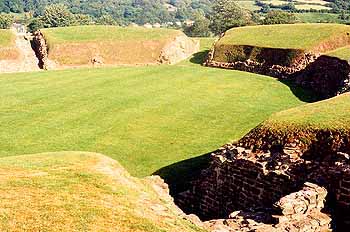
EBK Home
Kingdoms
Royalty
Saints
Pedigrees
Archaeology
King Arthur
Mail David
CAERLEON
 Dark
Age Capital of Wales?
Dark
Age Capital of Wales?
The town of Caerleon is mentioned so often in King Arthur's story, that it has become synonymous with his very name. If it were his Capital City, surely it is the true Camelot.
The Tradition: Stories of King Arthur holding court at Caerleon stretch back to the time of Geoffrey of Monmouth and further still to the oral traditions set down in the Mabinogion. Geoffrey says of Caerleon:
"Situated as it is in Morgannwg, on the River Usk, not far from the Severn Sea, in a most pleasant position, and being richer in material wealth than other townships, this city was eminently suitable...The river which I have named flowed by it on one side, and...On the other side, which was flanked by meadows and wooded groves, they had adorned the city with royal palaces, and by the gold-painted gables of its roofs it was a match for Rome. What is more, it was famous for its two churches. One of these, built in honour of the martyr Julius, was graced by a choir of most lovely virgins dedicated to God. The second, founded in the name of the blessed St. Aaron, the companion of Julius, was served by a monastery of canons, and counted the third metropolitan see of Britain. The city also contained a college of two hundred learned men, who were skilled in astronomy and the other arts and so by their careful computations prophesied for King Arthur any prodigies due at that time."
Caerleon was especially noted for "Arthur's Table", a huge grass-covered raised oval hollow around which King Arthur and his knights often sat. At one meeting there, King Arthur appointed St. Dyfrig as Archbishop of St. Aaron's Cathedral in Caerleon. He was later succeeded by St. Dewi (David) who removed the archdiocese to Mynwyr (St. Davids). It was to St. Julius' that Queen Gwenhwyfar retired after the Battle of Camlann, and here she apparently died.
Caerleon is also one of the possible sites of the well-known hidden cave where King Arthur and all his knights are said to sleep, waiting to be called upon to rescue their country in its hour of need. A local Caerleon farmer once met a mounted man in a three-cornered hat who took him to the middle of a large wood, promising to show him an amazing site. The man stopped at a sheer rock face where he pushed a great boulder aside to reveal the entrance to a long dark passage. The two entered within and followed the path to a series of steps above which hung two huge bells. From here they descended into a large underground cavern. All around them slept upwards of a thousands ancient knights and, at their head, the guide pointed out King Arthur himself. On leaving this solemn scene, the farmer accidentally knocked one of the great bells. Its loud clang awoke the sleepers, who immediately asked, "Is it time?". "Not yet," replied the stranger, "sleep on." The knights returned to their slumber and the two companions left for the surface. The stranger mounted his horse and departed without a word. The farmer often searched for the cave, in the years to come, but was never able to find it again.
Modern Archaeology: Caerleon appears repeatedly in ancient Arthurian writings as one of King Arthur's major residences. It was originally the Roman fortress of Isca Silurum, home of the 2nd Legion. However, despite many of its grand buildings surviving well into the 11th century, indications of occupation extending into the Dark Ages are slight. The so-called "Round Table" was fully excavated in 1926. It revealed the remains of the ancient Roman amphitheatre. However, one wonders if the methods of the time were sophisticated enough to recognise 6th century settlements such as those discovered in the amphitheatre at Cirencester. The Churches of SS. Aaron and Julius certainly appear to have existed: the latter at St. Julians, just west of the town, and the former at Penrhos to the north-east. Like other Roman towns in Britain, Caerleon may have become an early monastic centre as indicated by dedication of the parish church to St. Cadog. This is, apparently, a corruption of St. Cadfrod, its late 4th century founder. Caxton, however, did clearly state in his introduction to Sir Thomas Malory's "Le Morte D'Arthur" that Camelot was in Wales. Could he have been referring to Caerleon?
Possible Conclusions: Despite Caerleon's strong Arthurian associations, it is unlikely to have been the original Camelot. Certainly not in name and probably not in inspiration either. Indeed, Chrétien De Troyes, who first mentioned the romantic place-name, treats the two places as completely separate. It seems more likely that, during the Dark Ages, Caerleon was an ecclesiastic rather than a major secular centre. Perhaps, as such, it was seen as an appropriate meeting place for Royal councils. Such gatherings often met in circles in Celtic society, so what better meeting place than the old Roman amphitheatre?
